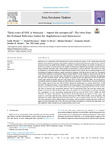2020-11-12Zeitschriftenartikel
Thirty years of VRE in Germany – “expect the unexpected”: The view from the National Reference Centre for Staphylococci and Enterococci
Werner, Guido
Neumann, Bernd
Weber, Robert E.
Kresken, Michael
Wendt, Constanze
Bender, Jennifer K.
VRE Study Group
Enterococci are commensals of the intestinal tract of many animals and humans. Of the various known and still unnamed new enterococcal species, only isolates of Enterococcus faecium and Enterococcus faecalis have received increased medical and public health attention. According to textbook knowledge, the majority of infections are caused by E. faecalis. In recent decades, the number of enterococcal infections has increased, with the increase being exclusively associated with a rising number of nosocomial E. faecium infections. This increase has been accompanied by the dissemination of certain hospital-acquired strain variants and an alarming progress in the development of antibiotic resistance namely vancomycin resistance. With this review we focus on a description of the specific situation of vancomycin resistance among clinical E. faecium isolates in Germany over the past 30 years. The present review describes three VRE episodes in Germany, each of which is framed by the beginning and end of the respective decade. The first episode is specified by the first appearance of VRE in 1990 and a country-wide spread of specific vanA-type VRE strains (ST117/CT24) until the late 1990s. The second decade was initially marked by regional clusters and VRE outbreaks in hospitals in South-Western Germany in 2004 and 2005, mainly caused by vanA-type VRE of ST203. Against the background of a certain “basic level” of VRE prevalence throughout Germany, an early shift from the vanA genotype to the vanB genotype in clinical isolates already occurred at the end of the 2000s without much notice. With the beginning of the third decade in 2010, VRE rates in Germany have permanently increased, first in some federal states and soon after country-wide. Besides an increase in VRE prevalence, this decade was marked by a sharp increase in vanB-type resistance and a dominance of a few, novel strain variants like ST192 and later on ST117 (CT71, CT469) and ST80 (CT1065). The largest VRE outbreak, which involved about 2,900 patients and lasted over three years, was caused by a novel and until that time, unknown strain type of ST80/CT1013 (vanB). Across all periods, VRE outbreaks were mainly oligoclonal and strain types varied over space (hospital wards) and time. The spread of VRE strains obviously respects political borders; for instance, both vancomycin-variable enterococci which were highly prevalent in Denmark and ST796 VRE which successfully disseminated in Australia and Switzerland, were still completely absent among German hospital patients, until to date.

